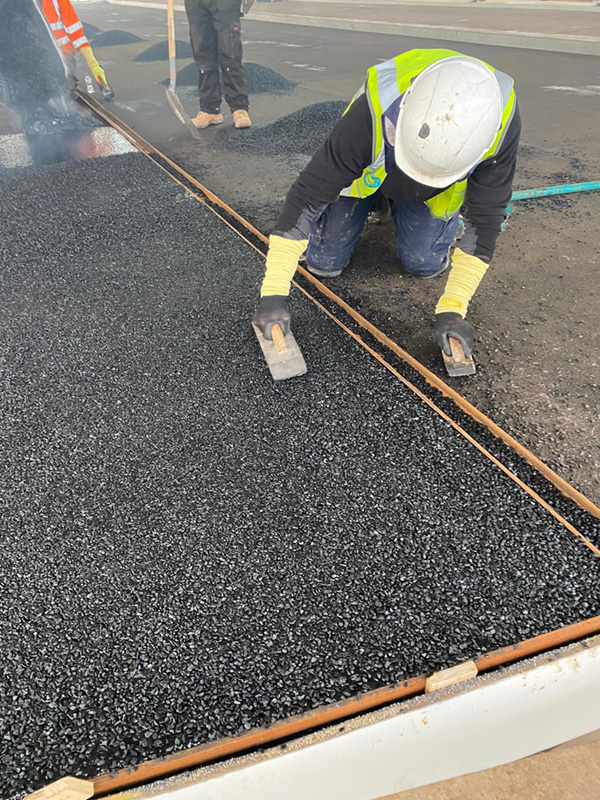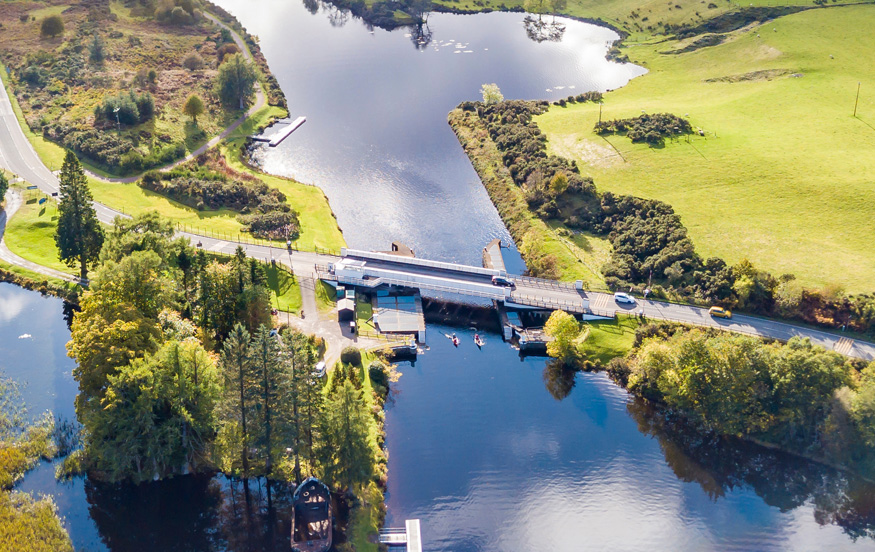Such is the versatility of mastic asphalt that it extends way beyond just flat roofing applications. As well as being suited for flooring, tanking, paving and balconies, mastic asphalt has a long track record of being installed on bridge decks as a highly durable waterproof surfacing system. In fact, mastic asphalt was the original surfacing on the Forth Road, Humber and Severn Crossing Bridges.
Mastic Asphalt Council (MAC) members IKO and BriggsAmasco have recently been involved in three high profile, challenging bridge projects in the Scottish Highlands, whereby IKO supplied the bridge surfacing mastic asphalt system and BriggsAmasco carried out the installations. The projects were carried out on the Laggan Swing Bridge in Laggan, the Torvean Swing Bridge in Inverness and the Benavie Swing Bridge in Fort William.
In the case of the Laggan Swing Bridge project, over 250m2 of bridge surfacing mastic asphalt was installed by BriggsAmasco following delivery of a total of 24 tonnes of mastic asphalt supplied in hot charge delivery vehicles ready to lay. The project was carried out in two phases – the first in October 2020 and the second in April 2021.
Located at the southern end of Loch Oich, the electrically-powered Laggan Swing Bridge removes a section of the A82 trunk road to allow the passage of vessels along the Caledonian Canal at North Laggan. The bridge resurfacing was carried out at night to ensure minimal disruption and to create a smoother and safer journey for motorists.
The existing surfacing was stripped out before 40mm of bridge surfacing mastic asphalt was installed on nominal 5mm rubberised bitumen waterproofing. Whilst the mastic asphalt was still hot, 6mm of bitumen coated chippings of a high PSV (Polished Stone Value) were broadcast into the surface to provide texture and skid resistance.
The Torvean Swing Bridge project differed in that it was a new bridge construction by Cleveland Bridge for main contractor R J McLeod. Officially opened in May 2021, the new Torvean Bridge forms a core element of efforts to reduce traffic bottlenecks in the city of Inverness. The bridge swings to make way for boats on the Caledonian Canal while also providing a new crossing for traffic.
BriggsAmasco was appointed by R J McLeod to install the bridge surfacing solution and 40mm of IKO’s bridge surfacing mastic asphalt system was applied on a proprietary PMMA liquid waterproofing system. The Torvean installation involved the application of 320m2 of mastic asphalt supplied in two deliveries totalling 32 tonnes in February this year.
Mastic asphalt was also chosen as the surfacing solution on the A830 Banavie Swing Bridge as part of essential maintenance work. A single track railway swing bridge immediately north of Banavie railway station, it carries the Fort William to Mallaig line at the foot of Neptune’s Staircase, a series of interconnected locks on the Caledonian Canal. The resurfacing work was carried out overnight and 7.5 tonnes of bridge surfacing mastic asphalt was delivered to site by IKO.
 On all three projects, the bridge surfacing mastic asphalt system used was manufactured in accordance with the ISO 9001 quality management system and BS EN 13108 Part 6, a harmonised European standard which specifies the requirements for mixtures of mastic asphalt for use on roads, airfields and other trafficked areas. Mastic asphalt is used for surface courses, binder courses, protection layers and inter-layers for bridges, tunnels and troughs.
On all three projects, the bridge surfacing mastic asphalt system used was manufactured in accordance with the ISO 9001 quality management system and BS EN 13108 Part 6, a harmonised European standard which specifies the requirements for mixtures of mastic asphalt for use on roads, airfields and other trafficked areas. Mastic asphalt is used for surface courses, binder courses, protection layers and inter-layers for bridges, tunnels and troughs.
Due to the location of the bridges in the Scottish Highlands and distance from the mastic asphalt manufacturing site, each of the projects posed their individual logistical challenges as it is notoriously difficult to supply waterproofing materials and maintain product quality. This type of product can ‘dry up’ over long periods of time as volatiles in the bitumen binder are released and the harder granite aggregates make the limestone aggregate slightly finer in composition through constant agitation.
It was vital to get the mix composition and temperature control correct at the point of manufacture as the projects were located an 11 hour trip away from IKO’s manufacturing facility in Grangemill, Derbyshire. Quality control was essential to ensure that the product was in pristine condition for BriggsAmasco to carry out the installations.
Close collaboration was crucial between IKO and BriggsAmasco, as BriggsAmasco had to quickly mobilise plant, equipment and operatives once the mastic asphalt was delivered to site. Vigilance also had to be applied with regards to weather forecasting for the hot charge deliveries and road closures for the client.
Even during the severe snow storms Scotland experienced during February, the deliveries to the Torvean Swing Bridge were still made on time and to the satisfaction of the installing contractor Briggs Amasco and the overseeing authorities such as Highland Council and Bear Scotland.
At all times BriggsAmasco had to help vehicle traffic move freely and allow boats to pass as necessary by maintaining close collaboration with clients and main contractors where appropriate. It was particularly important that the hot charge deliveries arrived on time.
Most hot charge deliveries of this nature can be managed with a single delivery driver within acceptable hours of work, however due to the large distances of travel, IKO called upon its haulier Punchards Haulage to supply the necessary additional drivers and units to again ensure the works were delivered safely and on time.
IKO’s bridge surfacing mastic asphalt system was chosen for these projects as it is a long established surface course for steel bridges. It provides a voidless, waterproof surface course and does not require any form of compaction. Unlike conventional road asphalts, it can be laid relatively thinly either by hand or suitable laying equipment at a nominal 40mm. It contributes to the overall weathertightness of the structure.
Whilst the mastic asphalt is still hot, pre-coated chippings can be spread and rolled into the surface to provide the necessary texture depth and skid resistance. The material can also provide the specifier with assurances from test data for resistance to fatigue, indirect tensile stiffness modulus, retained tensile strength (freeze/thaw) and bond strength.
This article featured within the July 2021 edition of RCi Magazine – click here to view the article.

